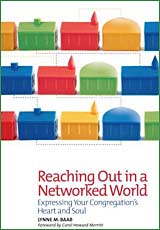Among church people, the rampant use of e-mail, websites, blogs, podcasts, desktop publishing software, and social networking sites seems to divide people into two camps: those who are immersed in this new communication technology (especially the young) and those who find this brave new world unfamiliar and intimidating. This timely and accessible resource offers a refreshing and insightful overview of these new technologies and the manifold ways they can convey the values, identity, and mission of congregations to the wider world.
Lynne Baab served in pastoral roles in two Seattle Presbyterian congregations before earning a Ph.D. in communication from the University of Washington in 2007. She is the author of three books and currently teaches pastoral theology in Dunedin, New Zealand.
Here she writes about how websites have replaced brochures and newsletters in many congregations. She spent two years looking at websites created by Protestant churches in the United States. They have understood the shift in our culture from verbal to visual information. Other shifts that have taken place are from principles to stories, from the individual to life in community, from religious institution to community of faith, from an emphasis on appearances to a desire for authenticity, and from an emphasis on unity to unity amidst diversity.The wonderful world of visual communication is increasingly a part of daily life and gives expression to experiences, participation, and connections to others. With great verve, Baab discusses websites (participatory and image driven), podcasts and streaming audio (experiential), video downloads and streaming video (experiential and image driven), online quizzes (participatory and connected), links to movie clips or YouTube clips (experiential, participatory, image driven, and connected), blogs (participatory, image driven, and connected), online groups (participatory, image driven, and connected), and search engines (participatory).
Baab also has many interesting ideas on the uses of listserves, wikis, desktop publishing, slogans, and projection screens in worship. This is an ideal resource for congregational leaders and any community interested in attracting younger people. Check out the communication audit at the back of the book to see where your congregation stands.
